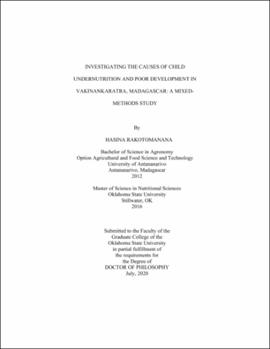| dc.contributor.advisor | Stoecker, Barbara J. | |
| dc.contributor.author | Rakotomanana, Hasina | |
| dc.date.accessioned | 2021-02-22T22:24:12Z | |
| dc.date.available | 2021-02-22T22:24:12Z | |
| dc.date.issued | 2020-07 | |
| dc.identifier.uri | https://hdl.handle.net/11244/328623 | |
| dc.description.abstract | The Vakinankaratra region of Madagascar has the highest burden of child undernutrition in the country. The purpose of this study was to investigate the factors associated with child undernutrition and to assess child development among children aged 6 to 23 months using a mixed-methods approach. Individual interviews (n = 8) and focus group discussions among fathers and mothers (10 with 63 total participants) were conducted. A sample of 391 mother-child dyads were included in the surveys and anthropometric measurements. Stunting rates were very high (69.4%) and 23.4% were underweight. Proportions of children achieving minimum dietary diversity (MDD) (35.8%) and consuming iron-rich foods (14.1%) were very low. Maternal knowledge of child feeding was associated with better feeding practices [Adjusted odds ratio: 1.2 (1.1 - 1.4)] for MDD. Consumption of iron-rich foods was significantly associated with lower odds of underweight [AOR: 0.3 (0.1 - 0.7)]. Barriers to optimal feeding practices included beliefs regarding certain foods considered as heavy, food insecurity, and heavy workload. Enablers include perceived benefits of appropriate complementary foods and positive relationships between the mothers and the community nutrition agents. Strong traditional gender roles around child care were a salient theme throughout the qualitative data as mothers were considered the primary child care providers. Fathers actively involved in child care activities would be ridiculed by the community and their wives would be considered lazy or unable to take care of their children. Besides providing for their families, fathers were also involved in home stimulation activities and support their wives with household chores when they were unavailable. Work conditions, separation and distance and reluctance prevented fathers from being more involved. Both fathers and mothers expressed interest in engaging fathers more in child care. Higher birthweight predicted increased length (B = 0.11), weight (B = 0.18), and weight-for-length (B = 0.13). Higher maternal height predicted increased both length (B = 0.17) and weight (B = 0.16), while larger household size was associated with lower length (B = -0.10) and weight (B = -0.16). Using the Bayley's scale, children aged 11 - 13 months had low cognitive, motor, language, and socioemotional development scores. | |
| dc.format | application/pdf | |
| dc.language | en_US | |
| dc.rights | Copyright is held by the author who has granted the Oklahoma State University Library the non-exclusive right to share this material in its institutional repository. Contact Digital Library Services at lib-dls@okstate.edu or 405-744-9161 for the permission policy on the use, reproduction or distribution of this material. | |
| dc.title | Investigating the causes of child undernutrition and poor development in Vakinankaratra, Madagascar: A mixed-methods study | |
| dc.contributor.committeeMember | Hildebrand, Deana | |
| dc.contributor.committeeMember | Gates, Gail | |
| dc.contributor.committeeMember | Fawbush-Razafimbelo, Fanjaniaina | |
| dc.contributor.committeeMember | Thomas, David | |
| osu.filename | Rakotomanana_okstate_0664D_16795.pdf | |
| osu.accesstype | Open Access | |
| dc.type.genre | Dissertation | |
| dc.type.material | Text | |
| dc.subject.keywords | child development | |
| dc.subject.keywords | child feeding | |
| dc.subject.keywords | fathers' involvement | |
| dc.subject.keywords | madagascar | |
| dc.subject.keywords | undernutrition | |
| thesis.degree.discipline | Nutritional Sciences | |
| thesis.degree.grantor | Oklahoma State University | |
